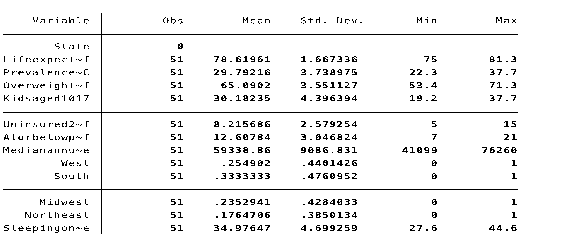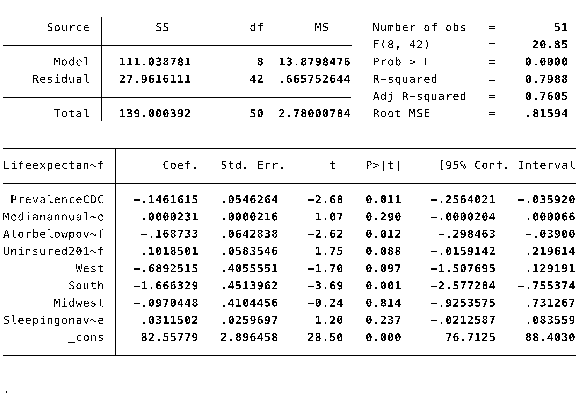The Correlation between sleep quality and State Obesity Rates
Introduction
Duration of sleep, the quality of sleep, and the frequency of sleep are topics for discussion when it comes to research into the world of sleep and its consequences on our bodies and health. Current statistics from the American Sleep Association indicate the 50-70 million individuals in the United States have a sleeping disorder. In our demographic present here today, 37% of 20-39 years old report short sleep duration, and 38% of adults have a BMI higher than 30kg/m^2 classified as obese. (ASA, 2018) In order to gain an insight on the correlating trends between obesity and sleep patterns, we must take a look at current data of sleep patterns and obesity trends. These may provide us insight on a stronger relationship and possible reciprocal influences between the two. Studies have shown increasing trends between weight gain/ obesity and poor sleep habits. The risk involved tends to vary on the sex and age group as everyone’s body reacts differently to different stimuli.
During the last few decades, the worldwide prevalence of obesity has doubled since 1980. (Finucane, etc. 2011) This obesity epidemic has been paralleled in modern society by a trend of reduced sleep duration. (CDC, 2011). More evidences both from laboratory and epidemiological studies shows that short sleep duration is a new risk factor for the development of obesity and its complications. (Knutson, 2010) Sleep is an important modulator of neuroendocrine function and glucose metabolism and sleep loss has been shown to result in metabolic and endocrine alterations, including decreased glucose tolerance and alteration of appetite regulating hormone. (Morselli, 2010) Today we are here to discuss some pressing issues in the relationship between sleep and obesity.
Literature Review
Sleep, like physical activities and diet, plays an important role in the growth, maturation, and health of children and adolescents by allowing for the diurnal rhythm of hormones related to growth, maturation, and energy homeostasis. (Chen, etc., 2007) Sleep is important in preventing obesity. Going to sleep early and waking up later, increasing sleep, may help prevent childhood obesity. Some research supported how long sleep duration made the risk of childhood obesity lower, while short sleep duration increased the risk of childhood obesity. Chen et al (2007) find that children with shorter sleep duration had a 58% higher risk of being overweight, and children with shortest sleep duration had an even higher risk. Using the meta-analysis, which supported gender difference in the association between sleep and obesity, boys had a harder time with sleep than girls. Another literature written by Leproult et al(2010) also talked about how obesity can interfere with sleep for children and adults. “Sleep is a restorative process of the brain, by the brain, and for the brain.” A good sleep plays a major role in neuroendocrine function and glucose metabolism. In their words: “Accumulating evidence from both epidemiologic studies and well-controlled laboratory studies indicates that chronic partial sleep loss may increase the risk of obesity and weight gain.”(Leproult, etc., 2010) Sleep is important for health of the entire body. The decrease in sleep duration and increase in sleep complaints in modern society
Empirical Model
The model that I use in this paper applies a linear regression to estimate the relationship that exists between obesity and sleep quality. The regression model is the following:
Obesity rate = α + β1 Age + β2 Sleep quality + β3 Income + β4 Region + u
In this linear regression model, the parameter (obesity) measures the percentage of the state population that can be identified as obese or overweight. The variables age and sleep quality represent the ratio of the individuals. Income indicates the median income for the state, and the region variable is used to control for the geographical location of the samples utilized; excluding northeast.
Data
The data for this study were retrieved from Centers for Disease Control and Prevention (CDC). The report includes sleep quality ( Sleeping on average
The table below displays the descriptive statistics of the dataset:

Table 1 displays that obesity rates can vary substantially from state to state, as do the sleep quality. On the other hand, by analyzing the dataset closely, we could identify some trends for both obesity rates and the sleeping hours for states belonging to certain geographic regions.
Empirical Results

The regression results illustrated in Table 2 show that, R-squared is about 0.799, close to 1, which means regression line and the data is fitted. The sleeping quality is the variable with the low significance (P > 0.05). Another important variable in the model is Income, which is statistically significant with P
Conclusions and Policy Implication
The results of the model utilized in this paper demonstrate that there is a direct correlation between sleep quality and state obesity rates. The obesity clinical management will require an extended amount of time and the assembly of a professional team to include dieting, exercise physiologist and psychologist. Controlling obesity in adults relies on improvements in nutritional habits, raised levels of physical activity, behavioral modification and psychotherapy, pharmaceutical treatment and maybe surgery.
References:
- Finucane MM, Stevens GA, Cowan MJ, et al.(2011,Feb) National, regional, and global trends in body-mass index since 1980: systematic analysis of health examination surveys and epidemiological studies with 960 country-years and 9.1 million participants. Lancet. 2011;377:557–567.
- https://www.ncbi.nlm.nih.gov/pmc/articles/PMC4472365/
- CDC (2011, March) Unhealthy sleep-related behaviors – 12 States, 2009. MMWR Morb Mortal Wkly Rep. 2011;60:233–238.
- https://www.cdc.gov/mmwr/preview/mmwrhtml/mm6008a2.htm
- Knutson KL. (2010, July) Sleep duration and cardiometabolic risk: a review of the epidemiologic evidence. Best Pract Res Clin Endocrinol Metab. 2010;24:731–743.
- https://www.sciencedirect.com/science/article/abs/pii/S1521690X10000680
- Morselli L, Leproult R, Balbo M, Spiegel K. (2010, Oct) Role of sleep duration in the regulation of glucose metabolism and appetite. Best Pract Res Clin Endocrinol Metab. 2010;24:687–702.
- https://www.ncbi.nlm.nih.gov/pmc/articles/PMC3018785/
- Chen, X., Beydoun, M., Wang, Y. (2007). Is sleep duration associated with childhood obesity. Pages 265-274. DOI: 10.1038/oby.2007.63
- https://onlinelibrary.wiley.com/doi/full/10.1038/oby.2007.63
- Leproult R, Van Cauter E.(2010) Role of sleep and sleep loss in hormonal release and metabolism. Endocr Dev. 2010;17:11–21.
- https://www.ncbi.nlm.nih.gov/pmc/articles/PMC3065172/
- American Sleep Association (2018, Feb), Sleep & Sleep Disorder Statistics
- https://www.sleepassociation.org/about-sleep/sleep-statistics/
- CCD(2001, March), Morbidity and Mortality Weekly Report
- https://www.cdc.gov/mmwr/PDF/wk/mm6008.pdf
Cite This Work
To export a reference to this article please select a referencing style below:
Related Content
All TagsContent relating to: "sleep"
Sleep is a complex physiological process that occurs in some extent in all animals, indicating its physiological importance. Sleep plays an important and intrinsic role in many behavioural and physiological functions.
Related Articles


